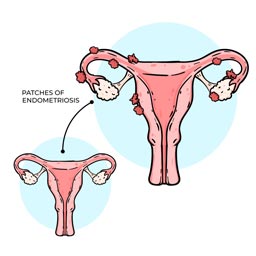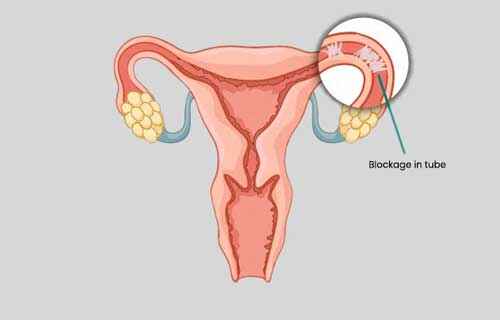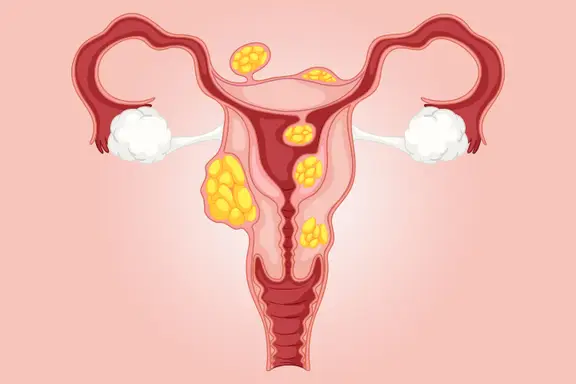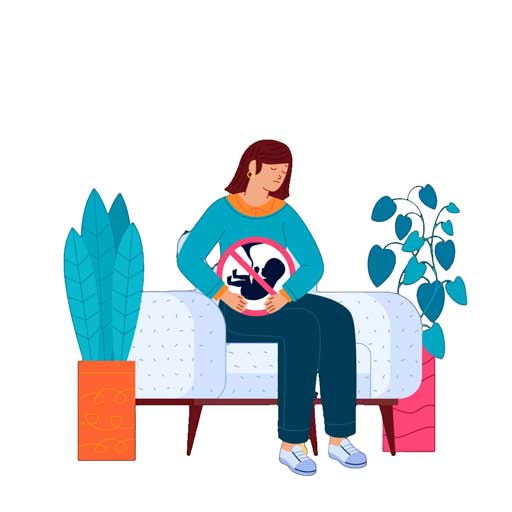
Introduction
Endometriosis is a chronic and painful condition where tissue similar to the lining inside the uterus, grows outside the uterus. This misplaced tissue can cause a variety of symptoms, including chronic pelvic pain, heavy menstrual bleeding, and infertility. The impact on a person’s quality of life can be profound. It can lead to physical discomfort, emotional distress, and significant disruptions to daily activities. We will discuss how Yoga for Endometriosis can provide solution for it.
Conventional treatments like medication and surgery are commonly used to manage endometriosis. However, many individuals seek complementary therapies to enhance their overall well-being and alleviate symptoms. Yoga has emerged as a popular and effective approach for managing the symptoms of endometriosis. This article explores the benefits of yoga for those living with endometriosis. It offers insights into how specific yoga practices can help in managing pain, reducing stress, and improving fertility.
Understanding Endometriosis and Its Symptoms
Endometriosis is a complex condition with no definitive cause. It occurs when tissue similar to the endometrial lining grows outside the uterus. It typically grows on the ovaries, fallopian tubes, and the tissue lining the pelvis. In rare cases, this tissue can spread beyond the pelvic organs. The exact cause of endometriosis remains unknown, but several theories suggest that it could be due to retrograde menstruation. It could also be due to immune system disorders, or genetic factors.

The symptoms of endometriosis vary but commonly include:
- Chronic pelvic pain, often associated with menstruation
- Pain during or after intercourse
- Painful bowel movements or urination, especially during menstruation
- Heavy menstrual bleeding or bleeding between periods
- Fatigue, diarrhea, constipation, bloating, and nausea
The chronic pain and other symptoms associated with endometriosis can be debilitating, making it crucial to find effective symptom relief strategies. Traditional treatments often include hormonal therapies and pain relievers, but these can come with side effects and may not fully address the symptoms.
Yoga for Endometriosis: An Overview
Yoga, a mind-body practice rooted in ancient Indian philosophy, has gained recognition as a beneficial complementary therapy for various health conditions, including endometriosis. But is yoga truly beneficial for endometriosis?
Research and anecdotal evidence suggest that yoga can significantly alleviate the symptoms of endometriosis by reducing pain, decreasing stress levels, and improving overall well-being. A study found that women with pain-associated endometriosis who practiced yoga reported a reduction in pelvic pain and improved quality of life. The practice of yoga involves a combination of physical postures (asanas), breathing techniques (pranayama), and meditation, all of which contribute to the holistic management of endometriosis symptoms.
The benefits of yoga for endometriosis include:
- Pain Relief: Yoga helps stretch and relax the pelvic muscles, reducing the tension that often contributes to pain. Certain poses, such as forward bends and gentle twists, can specifically target areas of discomfort.
- Stress Reduction: Endometriosis is often associated with high levels of stress, which can exacerbate symptoms. Yoga’s emphasis on breath control and meditation helps to calm the nervous system, reducing stress and promoting relaxation.
- Improved Circulation: Many yoga poses encourage blood flow to the pelvic region, which can help in reducing inflammation and promoting healing.
- Enhanced Emotional Well-being: Yoga fosters a sense of mindfulness and self-awareness, which can help individuals cope with the emotional toll of living with a chronic condition.
Yoga can play a supportive role in enhancing fertility in individuals with endometriosis. Stress, a known factor that can negatively impact fertility, is one area where yoga can make a significant difference. The relaxation and mindfulness achieved through yoga practice can help lower cortisol levels, thereby creating a more favorable environment for conception.
A study highlighted that women who practiced yoga experienced not only pain relief but also improved mental health and emotional stability, which are crucial for reproductive health. Although more research is needed, the stress-reduction benefits of yoga, coupled with its potential to balance hormones and improve blood circulation, make it a promising complementary approach for individuals facing fertility challenges due to endometriosis.
Best Asanas in Yoga for Endometriosis
Yoga offers numerous benefits for individuals with endometriosis, particularly in terms of pain relief, relaxation, and pelvic health. Additionally, these poses can support fertility by enhancing circulation, reducing stress, and promoting hormonal balance. Below are some of the most effective yoga poses for managing endometriosis symptoms and improving reproductive health.
Forward Folds in Yoga for Endometriosis
1. Forward Bend (Uttanasana)

Description: Uttanasana, or Forward Bend, involves standing with feet hip-width apart and folding forward from the hips, letting the head and arms hang towards the floor. This pose stretches the hamstrings, calves, and lower back, while also calming the mind.
Benefits: Forward Bend is particularly beneficial for relieving tension in the lower back, a common issue for those with endometriosis. The gentle stretch in the pelvic region helps reduce abdominal pressure and alleviate pelvic pain. This pose also promotes increased blood flow to the pelvic area, which can help reduce inflammation, support uterine health, and improve fertility. The calming effect of Uttanasana helps lower stress levels, fostering a more balanced hormonal environment, which is crucial for reproductive health.
2. Child’s Pose (Balasana)
Description: Balasana, or Child’s Pose, is a resting pose where you sit on your heels, stretch your arms forward, and lower your torso towards the ground. This gentle pose is deeply relaxing and helps to release tension in the back and hips.
Benefits: Child’s Pose is highly effective in reducing lower back pain and relaxing the hips, which are often affected by endometriosis. The pose gently stretches the muscles in the back, hips, and thighs, helping to relieve pelvic discomfort. Additionally, it encourages deep breathing, which calms the nervous system and helps manage stress, an important factor in both endometriosis management and fertility. By reducing stress and improving blood flow to the reproductive organs, Balasana supports overall pelvic health and enhances fertility.

Gentle Twists in Yoga for Endometriosis
3. Seated Spinal Twist (Ardha Matsyendrasana)
Description: Ardha Matsyendrasana, or Seated Spinal Twist, involves sitting with legs extended, bending one knee, crossing it over the other leg, and twisting the torso towards the bent knee. This pose is known for its detoxifying effects on the body.
Benefits: The Seated Spinal Twist helps detoxify the body by stimulating the digestive organs, which can alleviate bloating and discomfort commonly associated with endometriosis. The twist also massages the abdominal area, promoting healthy digestion and relieving tension in the lower back and pelvic region. Improved circulation in the pelvic area supports reproductive health by nourishing the uterus and ovaries, making this pose beneficial for both managing endometriosis symptoms and enhancing fertility.

4. Supine Twist
Description: Supine Twist is performed lying on your back with arms extended in a T-shape. One knee is bent and gently guided across the body, while the other leg remains straight, creating a twist in the spine.
Benefits: Supine Twist is a restorative pose that stretches the spine and relaxes the body. It helps alleviate lower back pain and gently massages the internal organs, which can be particularly soothing for those with endometriosis. The twisting motion enhances blood flow to the reproductive organs, promoting pelvic health and supporting fertility. By reducing tension and fostering relaxation, Supine Twist contributes to a more balanced and healthy reproductive system.
Hip Openers in Yoga for Endometriosis
5. Butterfly Pose (Baddha Konasana)
Description: Baddha Konasana, or Butterfly Pose, involves sitting with the soles of the feet together and knees dropping open to the sides. The hands hold the feet or ankles, gently pressing the knees towards the floor.
Benefits: Butterfly Pose is an excellent hip opener that enhances flexibility and circulation in the pelvic region. For individuals with endometriosis, this pose helps reduce tension and inflammation in the pelvic area, providing relief from pain and discomfort. The improved blood flow to the reproductive organs supports uterine and ovarian health, making this pose beneficial for fertility. By balancing the root chakra, Baddha Konasana fosters a more open and receptive state in the body, which is essential for reproductive health.

6. Pigeon Pose (Eka Pada Rajakapotasana)
Description: Eka Pada Rajakapotasana, or Pigeon Pose, involves extending one leg back while folding the other leg in front of you. The torso can remain upright or fold forward, deepening the stretch in the hips and glutes.
Benefits: Pigeon Pose is highly effective in releasing deep-seated tension in the hips and lower back, areas that are often tight and painful for those with endometriosis. The deep stretch in the psoas and glutes helps to alleviate pelvic pain and promote flexibility in the hip joints. Enhanced blood flow to the pelvic region supports reproductive health, aiding in hormonal balance and improving fertility. By encouraging the release of emotional and physical tension, Pigeon Pose creates a supportive environment for both managing endometriosis and enhancing fertility.

Restorative Poses in Yoga for Endometriosis
7. Legs-Up-the-Wall Pose (Viparita Karani)
Description: Viparita Karani, or Legs-Up-the-Wall Pose, involves lying on your back with your legs extended vertically up a wall. This restorative pose is deeply relaxing and helps to reverse the effects of gravity on the body.
Benefits: Legs-Up-the-Wall Pose encourages blood flow to the pelvic region, reducing inflammation and alleviating discomfort associated with endometriosis. The gentle inversion promotes relaxation and stress relief, both of which are crucial for managing endometriosis symptoms and supporting fertility. By enhancing circulation to the reproductive organs, this pose supports overall reproductive health, creating a nurturing environment for fertility.

8. Corpse Pose (Savasana)
Description: Savasana, or Corpse Pose, is the final resting pose in a yoga practice. Here you lie flat on your back with your arms at your sides and eyes closed. The pose promotes complete relaxation and integration of the benefits of the practice.
Benefits: Savasana is essential for reducing stress and promoting healing for individuals with endometriosis. The deep relaxation achieved in this pose calms the nervous system, reduces inflammation, and improves overall well-being. For those seeking to enhance fertility, Savasana helps to balance hormones and create a peaceful, receptive state in the body. By allowing the body to fully integrate the benefits of the yoga practice, Savasana supports both physical and emotional health. This is essential for managing endometriosis and fostering fertility.
Recommended Sequence in Yoga for Endometriosis:
- Start with a few minutes of deep breathing in a comfortable seated position to center the mind.
- Move into Child’s Pose for gentle stretching and relaxation.
- Transition into Butterfly Pose to open the hips and improve circulation.
- Practice Seated Spinal Twist on both sides to detoxify and massage the abdominal organs.
- Follow with Forward Bend to stretch the hamstrings and calm the nervous system.
- Perform Pigeon Pose on both sides to release tension in the hips.
- Finish with Legs-Up-the-Wall Pose and Savasana for deep relaxation.
Tips for Practicing Yoga for Endometriosis
Practicing yoga with endometriosis requires a focusing on the body’s signals and making necessary adjustments to ensure comfort and effectiveness. Here are some essential tips to help you get the most out of your practice:
Modifications and Adjustments
To make yoga poses more accessible and comfortable, it’s important to use props like blocks, bolsters, and straps. These tools can help you ease into poses without straining your body. For instance, in a Forward Bend (Uttanasana), placing a block under your forehead can reduce the strain on your lower back and allow you to relax more deeply into the pose. Similarly, using a bolster under your knees in Seated Forward Fold (Paschimottanasana) can make the pose more comfortable, especially when dealing with pelvic pain.
Listening to Your Body
One of the most crucial aspects of practicing yoga with endometriosis is learning to listen to your body. Endometriosis can cause varying levels of pain and discomfort, and it’s important to honor your body’s limitations. If a pose feels too intense or causes pain, don’t hesitate to modify it or skip it altogether. Remember, yoga is not about pushing through pain but rather finding a balance that supports your health and well-being.
Seeking Professional Guidance
If you’re new to yoga or if your endometriosis symptoms are severe, it’s highly recommended to work with a certified yoga therapist. A professional can tailor a yoga practice specifically to your needs, offering personalized adjustments and ensuring that your practice is both safe and effective. For those seeking specialized guidance, Yog4Lyf offers courses designed to support women dealing with infertility and other reproductive health issues through yoga. Our experienced instructors can provide you with the tools and support needed to manage endometriosis symptoms effectively while also focusing on enhancing your fertility.
Creating a Consistent Yoga Routine
Consistency is key to experiencing the full benefits of yoga for endometriosis. Here are a few tips to help you establish a regular practice:
- Set a Schedule: Designate specific times each day or week for your yoga practice. Even a short 15-20 minute session daily can make a significant difference in managing symptoms.
- Create a Dedicated Space: Set up a quiet, comfortable space at home for your yoga practice. Having a dedicated area can help reinforce your routine and make your practice more enjoyable.
- Incorporate Yoga into a Holistic Approach: Complement your yoga practice with other holistic approaches, such as a balanced diet, adequate sleep, and stress management techniques. This integrated approach can enhance your overall well-being.
- Utilize Resources: Explore online yoga classes, apps, or local studios that offer endometriosis-friendly practices. Connecting with a supportive community can provide valuable insights and keep you motivated.
- Engage with Knowledgeable Instructors: Look for instructors who specialize in yoga for women’s health or chronic pain conditions. At Yog4Lyf, our team of experts is dedicated to helping women overcome challenges related to endometriosis and infertility, offering tailored yoga programs that focus on long-term wellness.
By following these tips, you can create a yoga practice that not only helps manage endometriosis symptoms but also supports your overall reproductive health and well-being.
Conclusion
Yoga offers a holistic, empowering approach to managing the complex symptoms of endometriosis. This ancient practice transcends mere physical exercise by incorporating mindful movement, breath control, and deep relaxation. Together, these elements address both the physical and emotional challenges of the condition. By engaging in regular yoga practice, individuals with endometriosis can find significant relief from chronic pelvic pain. Additionally, yoga reduces stress and anxiety, which often accompany this condition.
Moreover, yoga enhances overall well-being by promoting better circulation, improving flexibility, and deepening the mind-body connection. Incorporating suggested poses like Forward Folds, Gentle Twists, Hip Openers, and Restorative Poses into your routine can create a practice tailored to your unique needs. These asanas not only help relieve pain and discomfort but also support reproductive health. This is especially beneficial for those struggling with fertility issues linked to endometriosis.
The journey toward managing endometriosis is deeply personal, and yoga can be a valuable tool in this process. By following tips for practicing yoga with endometriosis, including modifications and the use of props, you can make your practice more accessible and comfortable. Whether you are new to yoga or have practiced for years, exploring its benefits as a complementary treatment can be transformative. Embrace yoga as part of your holistic health strategy and take the first step toward greater well-being today.
References
*ARTICLE 1 [A Qualitative Study on the Practice of Yoga for Women with Pain-Associated Endometriosis]
*ARTICLE 2 [The Practice of Hatha Yoga for the Treatment of Pain Associated with Endometriosis]


